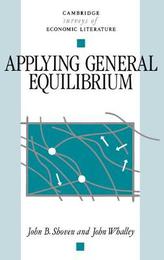
|
Applying General Equilibrium
Hardback
Main Details
| Title |
Applying General Equilibrium
|
| Authors and Contributors |
By (author) John B. Shoven
|
|
By (author) John Whalley
|
| Series | Cambridge Surveys of Economic Literature |
|---|
| Physical Properties |
| Format:Hardback | | Pages:312 | | Dimensions(mm): Height 236,Width 155 |
|
| Category/Genre | Economic theory and philosophy |
|---|
| ISBN/Barcode |
9780521266550
|
| Classifications | Dewey:330.01 |
|---|
| Audience | | Professional & Vocational | |
|---|
| Illustrations |
40 Tables, unspecified; 26 Line drawings, unspecified
|
|
Publishing Details |
| Publisher |
Cambridge University Press
|
| Imprint |
Cambridge University Press
|
| Publication Date |
29 May 1992 |
| Publication Country |
United Kingdom
|
Description
The aim of this book is to make more widely available a body of recent research activity that has become known as applied general equilibrium analysis. The central idea underlying this work is to convert the Walrasian general equilibrium structure (formalized in the 1950s by Kenneth Arrow, Gerard Debreu and others) from an abstract representation of an economy into realistic models of actual economies. Numerical, empirically based general equilibrium models can then be used to evaluate concrete policy options by specifying production and demand parameters and incorporating data reflective of real economies. Shoven and Whalley describe all aspects of developing applied general equilibrium models, including developing an appropriate equilibrium structure, calibrating the model, compiling counterfactual equilibria, and interpreting results. The authors contend that the Walrasian general equilibrium model provides an ideal framework for appraising the effects of policy changes on resource allocation, assessing who gains and who loses, and the policy impacts not well covered by empirical macro models. The applications in the book illustrate a number of ways in which fresh insights are provided in long standing policy controversies.
Reviews'Given that the authors count as being among the most creative, influential and prolific in this area, one expects that this is going to be a fascinating tour. And, indeed, it is. All aspects of model building and use for policy analysis are discussed and illustrated in elegant and lively style ... All this is presented in a masterly way.' Economica
|